University Essay: Richard Titmuss Social Welfare Framework
VerifiedAdded on 2022/08/22
|5
|1154
|33
Essay
AI Summary
This essay analyzes Richard Titmuss's social division of welfare framework, which includes fiscal, occupational, and social welfare divisions. The essay provides definitions of each type of welfare, highlighting how they target low-income groups and marginalized sections. Fiscal welfare, according to Titmuss, involves tax breaks and allowances. Occupational welfare includes benefits provided by employers. Social welfare involves institutional aid from the state. The essay incorporates personal reflections and experiences, such as the author's mother's experience with Centrelink payments and the author's experience with youth allowances, to illustrate how these welfare divisions function in real-life scenarios. The conclusion emphasizes the importance of these welfare schemes in uplifting marginalized sections of society and reducing economic disparity.
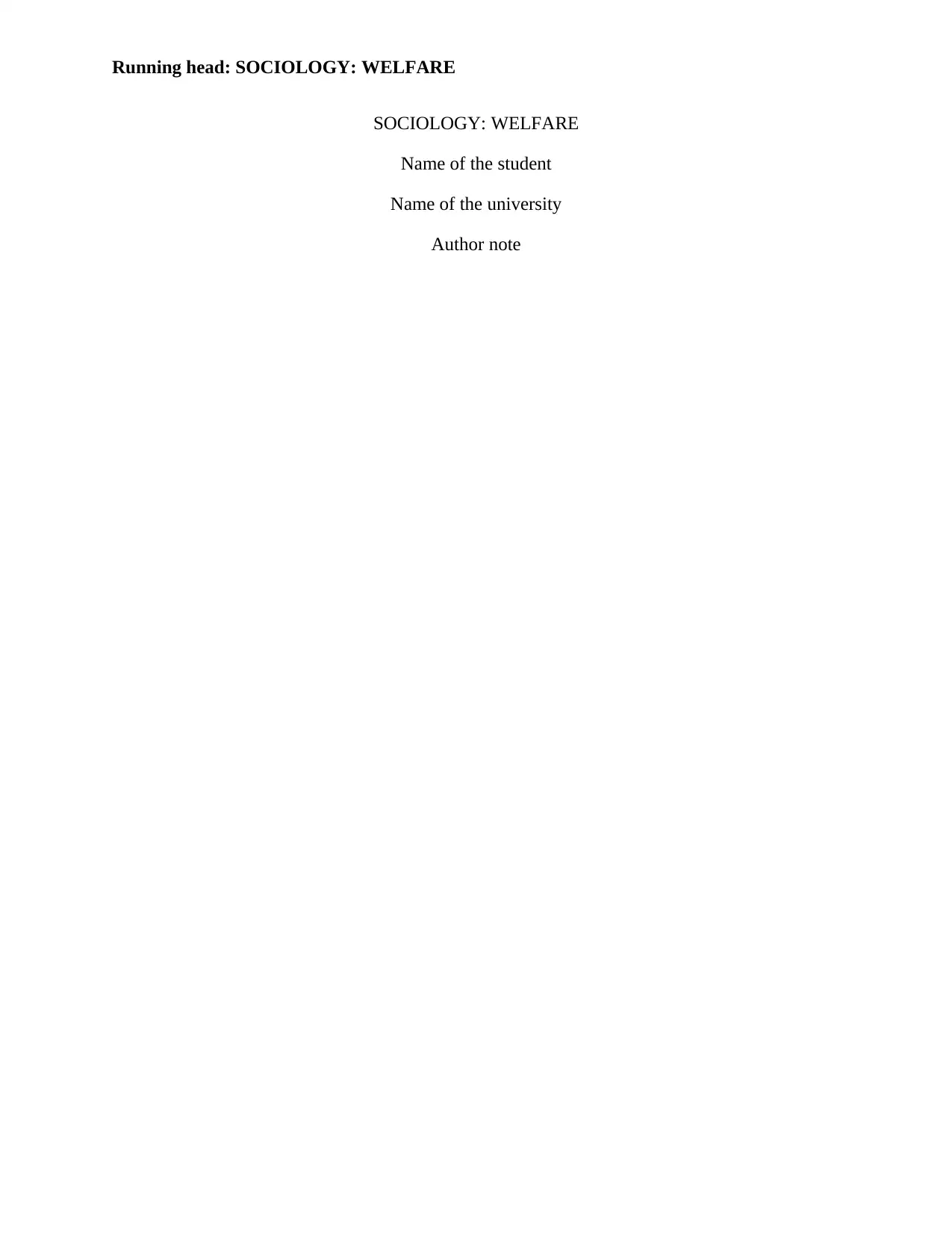
Running head: SOCIOLOGY: WELFARE
SOCIOLOGY: WELFARE
Name of the student
Name of the university
Author note
SOCIOLOGY: WELFARE
Name of the student
Name of the university
Author note
Paraphrase This Document
Need a fresh take? Get an instant paraphrase of this document with our AI Paraphraser
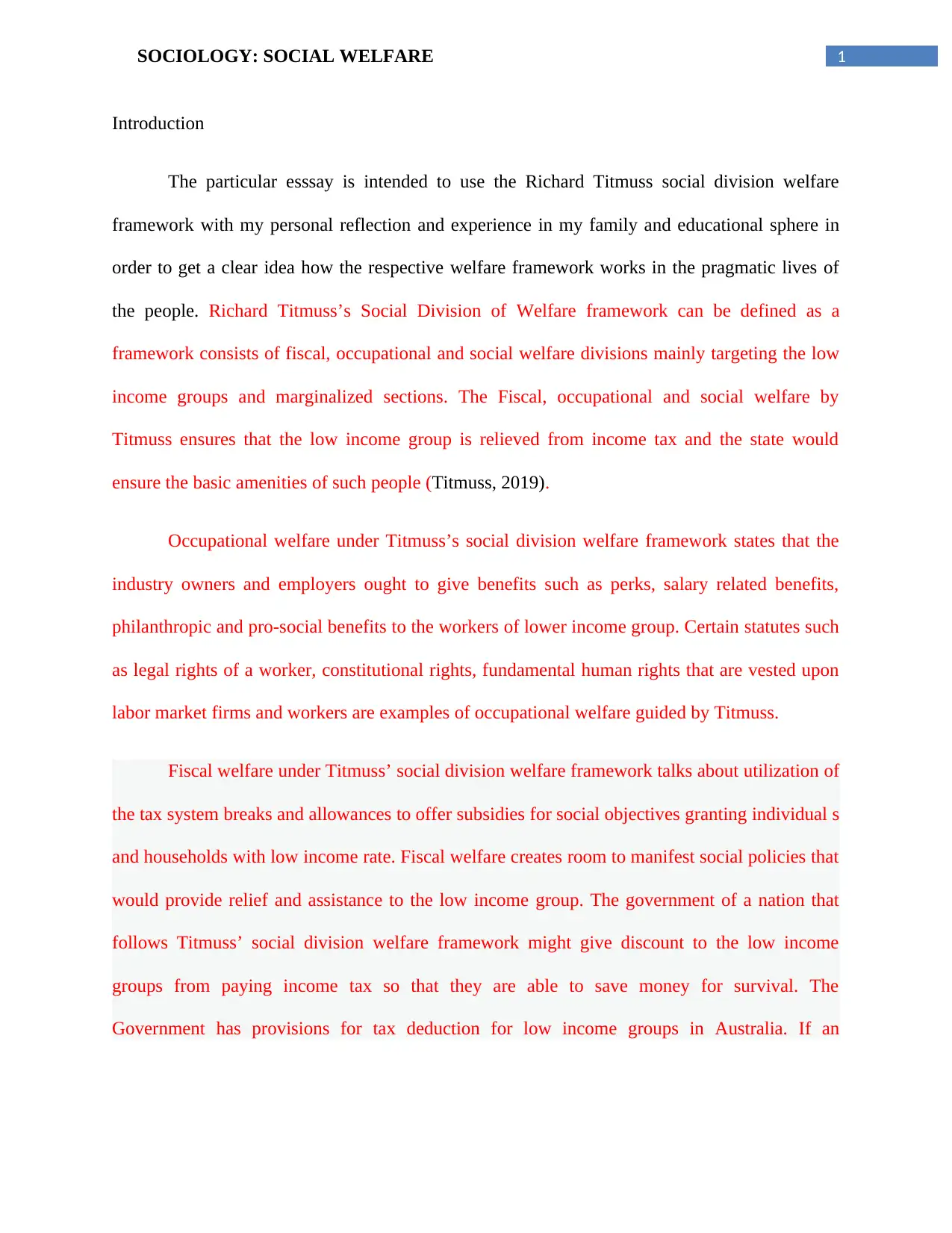
1SOCIOLOGY: SOCIAL WELFARE
Introduction
The particular esssay is intended to use the Richard Titmuss social division welfare
framework with my personal reflection and experience in my family and educational sphere in
order to get a clear idea how the respective welfare framework works in the pragmatic lives of
the people. Richard Titmuss’s Social Division of Welfare framework can be defined as a
framework consists of fiscal, occupational and social welfare divisions mainly targeting the low
income groups and marginalized sections. The Fiscal, occupational and social welfare by
Titmuss ensures that the low income group is relieved from income tax and the state would
ensure the basic amenities of such people (Titmuss, 2019).
Occupational welfare under Titmuss’s social division welfare framework states that the
industry owners and employers ought to give benefits such as perks, salary related benefits,
philanthropic and pro-social benefits to the workers of lower income group. Certain statutes such
as legal rights of a worker, constitutional rights, fundamental human rights that are vested upon
labor market firms and workers are examples of occupational welfare guided by Titmuss.
Fiscal welfare under Titmuss’ social division welfare framework talks about utilization of
the tax system breaks and allowances to offer subsidies for social objectives granting individual s
and households with low income rate. Fiscal welfare creates room to manifest social policies that
would provide relief and assistance to the low income group. The government of a nation that
follows Titmuss’ social division welfare framework might give discount to the low income
groups from paying income tax so that they are able to save money for survival. The
Government has provisions for tax deduction for low income groups in Australia. If an
Introduction
The particular esssay is intended to use the Richard Titmuss social division welfare
framework with my personal reflection and experience in my family and educational sphere in
order to get a clear idea how the respective welfare framework works in the pragmatic lives of
the people. Richard Titmuss’s Social Division of Welfare framework can be defined as a
framework consists of fiscal, occupational and social welfare divisions mainly targeting the low
income groups and marginalized sections. The Fiscal, occupational and social welfare by
Titmuss ensures that the low income group is relieved from income tax and the state would
ensure the basic amenities of such people (Titmuss, 2019).
Occupational welfare under Titmuss’s social division welfare framework states that the
industry owners and employers ought to give benefits such as perks, salary related benefits,
philanthropic and pro-social benefits to the workers of lower income group. Certain statutes such
as legal rights of a worker, constitutional rights, fundamental human rights that are vested upon
labor market firms and workers are examples of occupational welfare guided by Titmuss.
Fiscal welfare under Titmuss’ social division welfare framework talks about utilization of
the tax system breaks and allowances to offer subsidies for social objectives granting individual s
and households with low income rate. Fiscal welfare creates room to manifest social policies that
would provide relief and assistance to the low income group. The government of a nation that
follows Titmuss’ social division welfare framework might give discount to the low income
groups from paying income tax so that they are able to save money for survival. The
Government has provisions for tax deduction for low income groups in Australia. If an
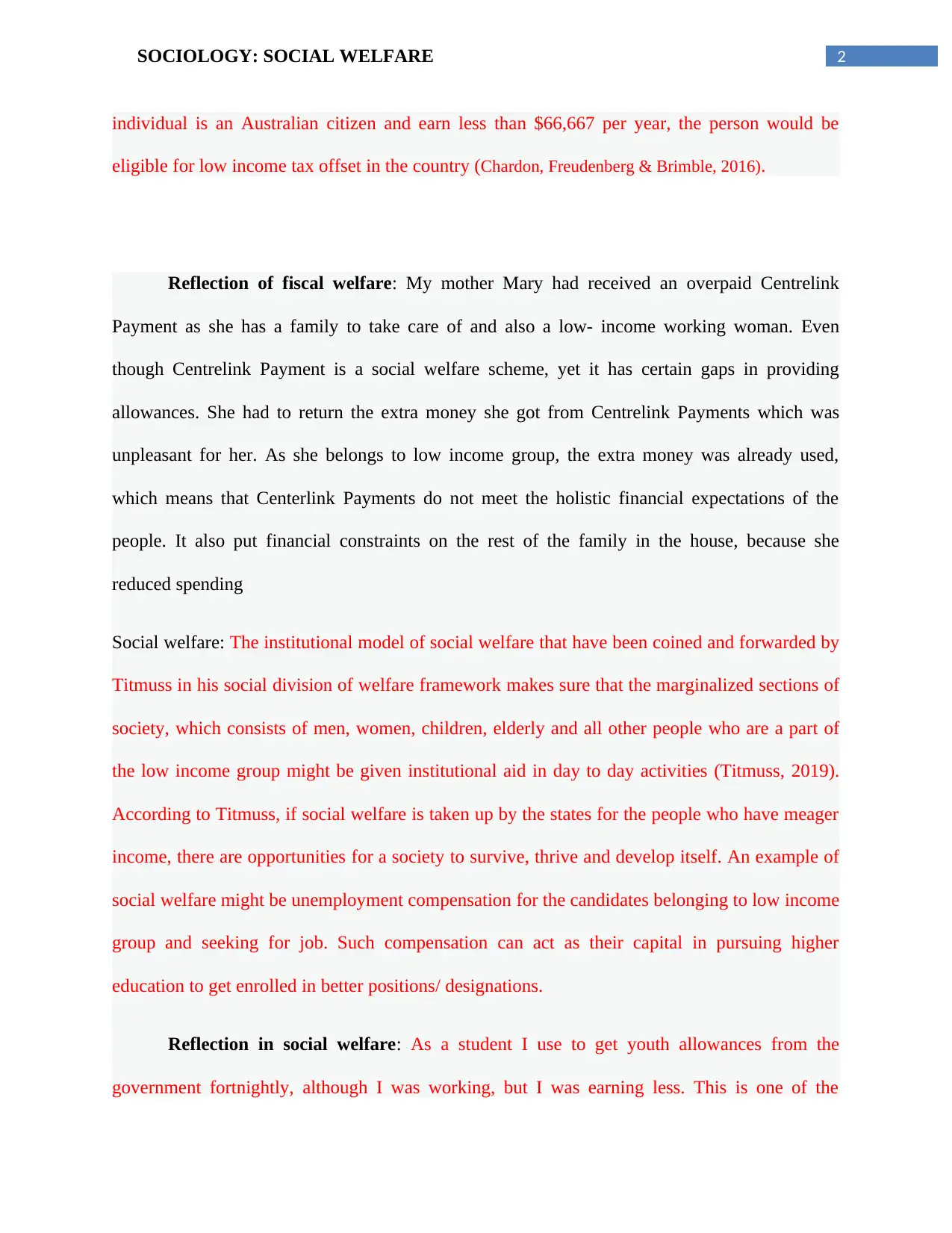
2SOCIOLOGY: SOCIAL WELFARE
individual is an Australian citizen and earn less than $66,667 per year, the person would be
eligible for low income tax offset in the country (Chardon, Freudenberg & Brimble, 2016).
Reflection of fiscal welfare: My mother Mary had received an overpaid Centrelink
Payment as she has a family to take care of and also a low- income working woman. Even
though Centrelink Payment is a social welfare scheme, yet it has certain gaps in providing
allowances. She had to return the extra money she got from Centrelink Payments which was
unpleasant for her. As she belongs to low income group, the extra money was already used,
which means that Centerlink Payments do not meet the holistic financial expectations of the
people. It also put financial constraints on the rest of the family in the house, because she
reduced spending
Social welfare: The institutional model of social welfare that have been coined and forwarded by
Titmuss in his social division of welfare framework makes sure that the marginalized sections of
society, which consists of men, women, children, elderly and all other people who are a part of
the low income group might be given institutional aid in day to day activities (Titmuss, 2019).
According to Titmuss, if social welfare is taken up by the states for the people who have meager
income, there are opportunities for a society to survive, thrive and develop itself. An example of
social welfare might be unemployment compensation for the candidates belonging to low income
group and seeking for job. Such compensation can act as their capital in pursuing higher
education to get enrolled in better positions/ designations.
Reflection in social welfare: As a student I use to get youth allowances from the
government fortnightly, although I was working, but I was earning less. This is one of the
individual is an Australian citizen and earn less than $66,667 per year, the person would be
eligible for low income tax offset in the country (Chardon, Freudenberg & Brimble, 2016).
Reflection of fiscal welfare: My mother Mary had received an overpaid Centrelink
Payment as she has a family to take care of and also a low- income working woman. Even
though Centrelink Payment is a social welfare scheme, yet it has certain gaps in providing
allowances. She had to return the extra money she got from Centrelink Payments which was
unpleasant for her. As she belongs to low income group, the extra money was already used,
which means that Centerlink Payments do not meet the holistic financial expectations of the
people. It also put financial constraints on the rest of the family in the house, because she
reduced spending
Social welfare: The institutional model of social welfare that have been coined and forwarded by
Titmuss in his social division of welfare framework makes sure that the marginalized sections of
society, which consists of men, women, children, elderly and all other people who are a part of
the low income group might be given institutional aid in day to day activities (Titmuss, 2019).
According to Titmuss, if social welfare is taken up by the states for the people who have meager
income, there are opportunities for a society to survive, thrive and develop itself. An example of
social welfare might be unemployment compensation for the candidates belonging to low income
group and seeking for job. Such compensation can act as their capital in pursuing higher
education to get enrolled in better positions/ designations.
Reflection in social welfare: As a student I use to get youth allowances from the
government fortnightly, although I was working, but I was earning less. This is one of the
⊘ This is a preview!⊘
Do you want full access?
Subscribe today to unlock all pages.

Trusted by 1+ million students worldwide
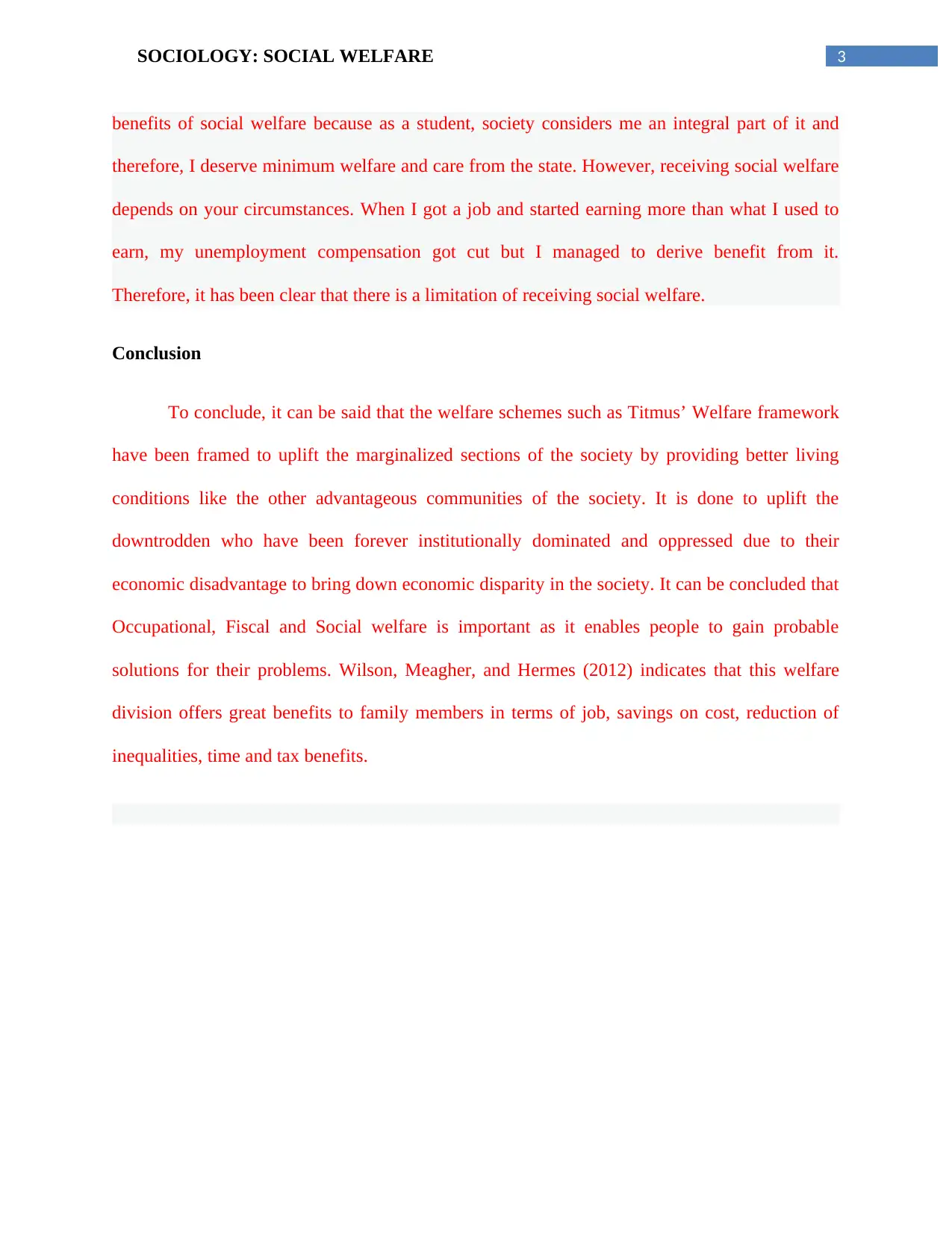
3SOCIOLOGY: SOCIAL WELFARE
benefits of social welfare because as a student, society considers me an integral part of it and
therefore, I deserve minimum welfare and care from the state. However, receiving social welfare
depends on your circumstances. When I got a job and started earning more than what I used to
earn, my unemployment compensation got cut but I managed to derive benefit from it.
Therefore, it has been clear that there is a limitation of receiving social welfare.
Conclusion
To conclude, it can be said that the welfare schemes such as Titmus’ Welfare framework
have been framed to uplift the marginalized sections of the society by providing better living
conditions like the other advantageous communities of the society. It is done to uplift the
downtrodden who have been forever institutionally dominated and oppressed due to their
economic disadvantage to bring down economic disparity in the society. It can be concluded that
Occupational, Fiscal and Social welfare is important as it enables people to gain probable
solutions for their problems. Wilson, Meagher, and Hermes (2012) indicates that this welfare
division offers great benefits to family members in terms of job, savings on cost, reduction of
inequalities, time and tax benefits.
benefits of social welfare because as a student, society considers me an integral part of it and
therefore, I deserve minimum welfare and care from the state. However, receiving social welfare
depends on your circumstances. When I got a job and started earning more than what I used to
earn, my unemployment compensation got cut but I managed to derive benefit from it.
Therefore, it has been clear that there is a limitation of receiving social welfare.
Conclusion
To conclude, it can be said that the welfare schemes such as Titmus’ Welfare framework
have been framed to uplift the marginalized sections of the society by providing better living
conditions like the other advantageous communities of the society. It is done to uplift the
downtrodden who have been forever institutionally dominated and oppressed due to their
economic disadvantage to bring down economic disparity in the society. It can be concluded that
Occupational, Fiscal and Social welfare is important as it enables people to gain probable
solutions for their problems. Wilson, Meagher, and Hermes (2012) indicates that this welfare
division offers great benefits to family members in terms of job, savings on cost, reduction of
inequalities, time and tax benefits.
Paraphrase This Document
Need a fresh take? Get an instant paraphrase of this document with our AI Paraphraser
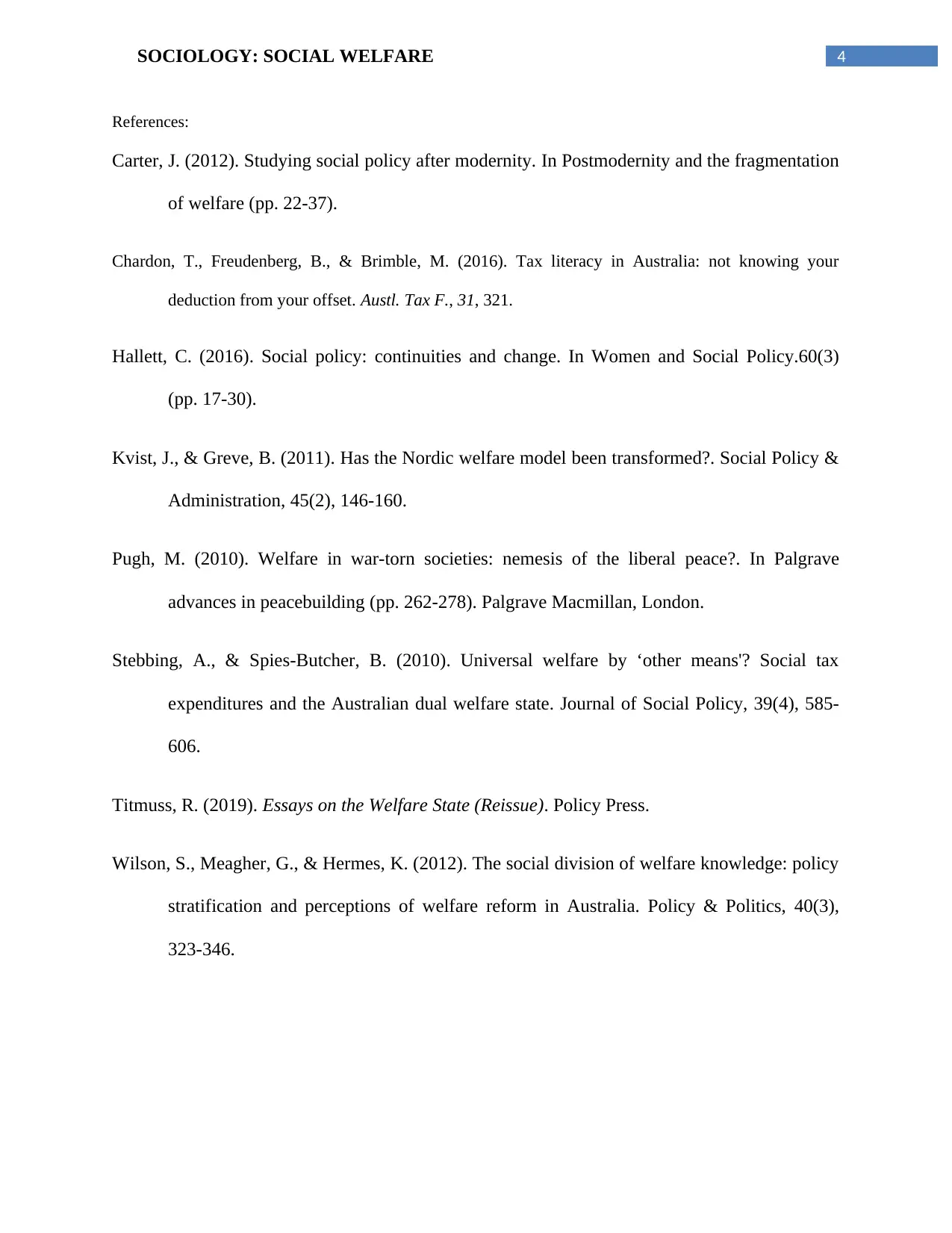
4SOCIOLOGY: SOCIAL WELFARE
References:
Carter, J. (2012). Studying social policy after modernity. In Postmodernity and the fragmentation
of welfare (pp. 22-37).
Chardon, T., Freudenberg, B., & Brimble, M. (2016). Tax literacy in Australia: not knowing your
deduction from your offset. Austl. Tax F., 31, 321.
Hallett, C. (2016). Social policy: continuities and change. In Women and Social Policy.60(3)
(pp. 17-30).
Kvist, J., & Greve, B. (2011). Has the Nordic welfare model been transformed?. Social Policy &
Administration, 45(2), 146-160.
Pugh, M. (2010). Welfare in war-torn societies: nemesis of the liberal peace?. In Palgrave
advances in peacebuilding (pp. 262-278). Palgrave Macmillan, London.
Stebbing, A., & Spies-Butcher, B. (2010). Universal welfare by ‘other means'? Social tax
expenditures and the Australian dual welfare state. Journal of Social Policy, 39(4), 585-
606.
Titmuss, R. (2019). Essays on the Welfare State (Reissue). Policy Press.
Wilson, S., Meagher, G., & Hermes, K. (2012). The social division of welfare knowledge: policy
stratification and perceptions of welfare reform in Australia. Policy & Politics, 40(3),
323-346.
References:
Carter, J. (2012). Studying social policy after modernity. In Postmodernity and the fragmentation
of welfare (pp. 22-37).
Chardon, T., Freudenberg, B., & Brimble, M. (2016). Tax literacy in Australia: not knowing your
deduction from your offset. Austl. Tax F., 31, 321.
Hallett, C. (2016). Social policy: continuities and change. In Women and Social Policy.60(3)
(pp. 17-30).
Kvist, J., & Greve, B. (2011). Has the Nordic welfare model been transformed?. Social Policy &
Administration, 45(2), 146-160.
Pugh, M. (2010). Welfare in war-torn societies: nemesis of the liberal peace?. In Palgrave
advances in peacebuilding (pp. 262-278). Palgrave Macmillan, London.
Stebbing, A., & Spies-Butcher, B. (2010). Universal welfare by ‘other means'? Social tax
expenditures and the Australian dual welfare state. Journal of Social Policy, 39(4), 585-
606.
Titmuss, R. (2019). Essays on the Welfare State (Reissue). Policy Press.
Wilson, S., Meagher, G., & Hermes, K. (2012). The social division of welfare knowledge: policy
stratification and perceptions of welfare reform in Australia. Policy & Politics, 40(3),
323-346.
1 out of 5
Your All-in-One AI-Powered Toolkit for Academic Success.
+13062052269
info@desklib.com
Available 24*7 on WhatsApp / Email
![[object Object]](/_next/static/media/star-bottom.7253800d.svg)
Unlock your academic potential
Copyright © 2020–2025 A2Z Services. All Rights Reserved. Developed and managed by ZUCOL.
